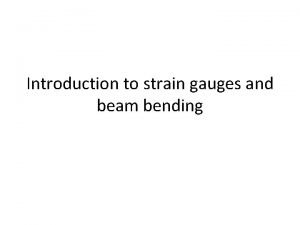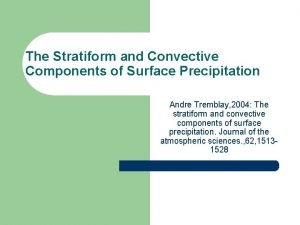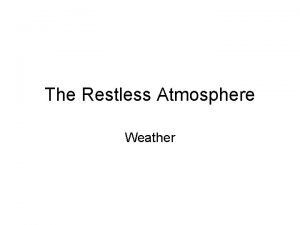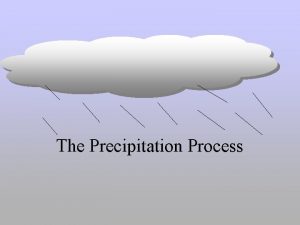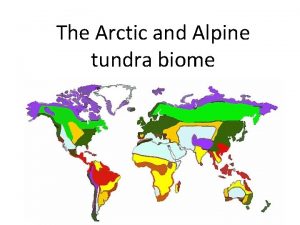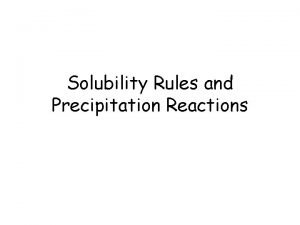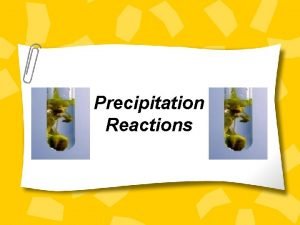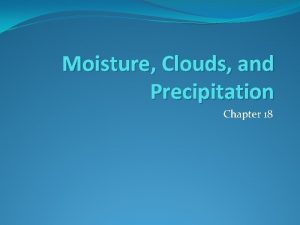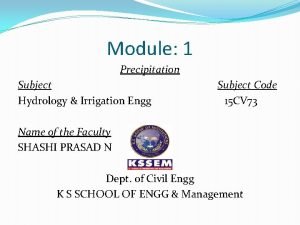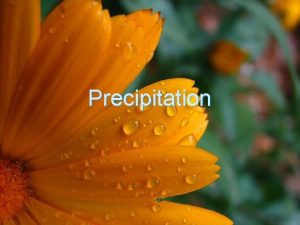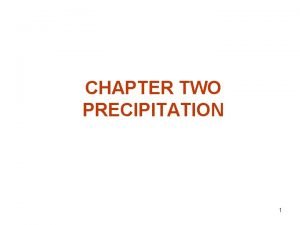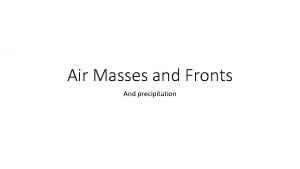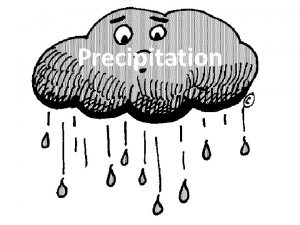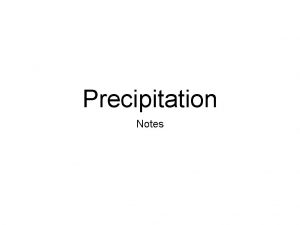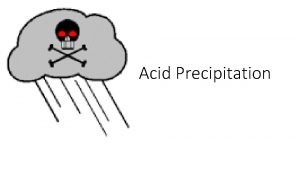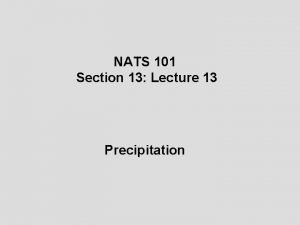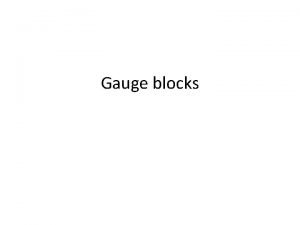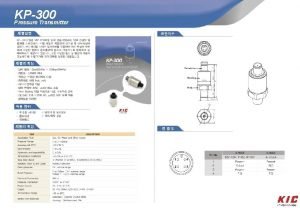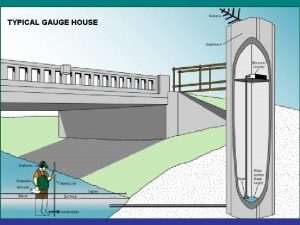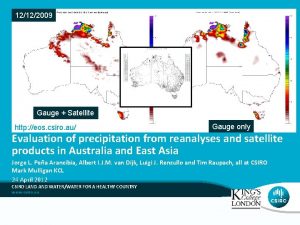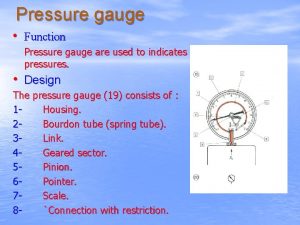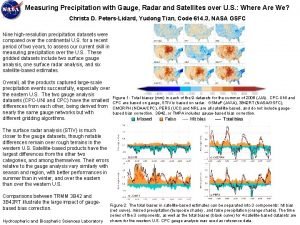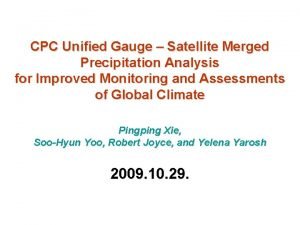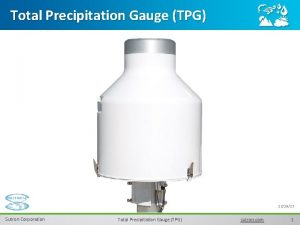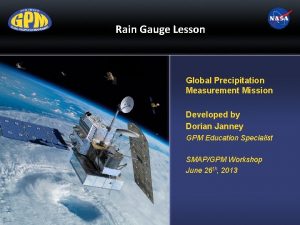PRECIPITATIO N GAUGE NETWORK LECTURE 5 PRECIPITATION GAUGE


























- Slides: 26

PRECIPITATIO N GAUGE NETWORK LECTURE 5

PRECIPITATION GAUGE NETWORK To have an idea of areal distribution of precipitation there should be adequately planned rain gauge network There are two reasons to plan a network: 1. Catch area of a precipitation gauge is very small 2. Amount of precipitation varies from place to place

PRECIPITATION GAUGE NETWORK IN PAKISTAN

GAUGE DENSITY (G. D)

W. M. O RECOMMENDED GAUGE DENSITIES 1. For Flat regions 600 -900 Km 2 /station 2. For mountainous regions 100 -250 Km 2 /station 3. For small mountainous islands 25 Km 2 /station 4. For arid and polar zones 1500 -10, 000 Km 2 /station

Topography For hilly terrains G. D should be lesser because generally more rains and more variations Hydro-meteorology Areas with more precipitation should have less G. D FACTORS AFFECTING GAUGE DENSITY Stream network Denser stream network lesser will be G. D Population density More population lesser should be G. D Economy Lesser G. D. P more G. D Interest Climatological station is must on airports and water control reservoirs Research Lesser G. D results in better output

INTERPRETATION OF PRECIPITATION DATA FROM A GAUGE NETWORK Interpretation of rain data coming from a rain gauge network includes 1. Estimation of missing precipitation data 2. Checking consistency in precipitation data record 3. Determination of average areal precipitation

1. ESTIMATION OF MISSING PRECIPITATION DATA According to US environmental data services, for estimation of missing precipitation record, there should be atleast three surrounding stations (Index Stations) Index stations should be having more or less same effective radii as station “X” (station for which precipitation data is missing) And these stations should be more or less equally spaced around station “X” C A X B

1. ESTIMATION OF MISSING PRECIPITATION DATA C A X B

a)ARITHMETIC MEAN METHOD C A X B

b)NORMAL RATIO METHOD C A X B

NUMERICAL PROBLEM Precipitation station X was inoperative on 24 august, 2010. The precipitation records for the same date at three surrounding stations A, B and C were 82, 87 and 97 mm respectively. Normal Annual Precipitations at station X, A, B and C are 920, 800, 810 and 950 mm respectively

NUMERICAL PROBLEM

2. CONSISTENCY OF PRECIPITATION RECORD Double mass analysis tests the consistency of the record at a station by comparing its accumulated annual or seasonal precipitation with concurrent accumulated values of mean precipitation for a group of surrounding stations A change in the slope indicates a change in precipitation regime at station. Any change due to meteorological reasons will not cause change in slope because all the base stations and the station whose consistency is in question will be affected equally

DOUBLE MASS CURVE

DOUBLE MASS CURVE

Number of surrounding stations should be atleast 10 DOUBLE MASS CURVE Considerable caution must be exercised in applying this technique. Because the plotted points deviate about a mean line and changes in slope should be only accepted if there is a marked difference substantiated by other evidences too. If the slope change remains for a period less than 5 years this change is ignored. Data is considered consistent Depending upon conditions any of the data before or after the change year may be reliable but generally latest data is taken as reliable.

CAUSES OF INCONSISTENCY Change in the location e. g. , gauge near a river site Change in the instrument e. g. , modern, better performance Change in observational procedures

Average depth of precipitation over a specific area on a storm, seasonal or annual basis is required in many types of hydrologic problems. 3. AVERAGING PRECIPITATION OVER AN AREA This average depth when multiplied with the area under consideration provides total volume of water generated in a storm, or seasonally or annually. There are mainly three methods to compute average depth 1. Arithmetic average 2. Thissen’s method 3. Isohyetal method

Simplest method of obtaining average depth over an area is arithmetic mean of the gauges present in the area a) ARITHMETIC AVERAGE METHOD This technique yields good estimated in flat countries where the gauges are more or less uniformly spaced And individual gauge catches do not vary much from the mean value These limitations can be partially overcome if topographical influences and areal representation are considered while installing gauges

Applicability: 1. 2. 3. a) ARITHMETIC AVERAGE METHOD Uniform precipitation almost at all stations Stations are equally spaced in the area For very small and plane areas results may be satisfactory Merits: This is a quick and simple method Demerits: When there is variation in precipitation almost 10% from the mean value outcome is not very true. Also not applicable to areas with unequal spacing between stations. These are generally most encountered conditions

This method attempts to allow for non-uniform distribution of gauges by providing a weighing factor for each gauge Stations are plotted on a map and connecting lines are drawn b) THE THISSEN’S METHOD Perpendicular bisectors are marked and by their intersection polygons are made. Each polygon is effective area for that gauge. Area of each gauge is determined then by planimetry and is presented as percentage of total area Weighted average rainfall for the total area is computed by multiplying the precipitation over each gauge and its effective area by summing the product of areas and precipitations and dividing by total area average rainfall can be estimated

b) THE THISSEN’S METHOD

Applicability: Applicable for large and variable precipitation areas. Effective areas are computed to reduce variations which was a hindrance in calculations of simple arithmetic method. b) THE THISSEN’S METHOD Merits: Applicable to large and variable areas Better results as compared to arithmetic mean method Demerits: This is a time taking and hectic technique Assumptions are rigid and abrupt in precipitation values for any polygon which is un-natural And there is a requirement for replotting the map and do all the work again if there is a change in the location of a gauge or there is a new instrument installed

This is the most accurate method when used by experienced analyst c) THE ISOHYETAL METHOD Station locations and amounts of precipitations are plotted on the map Contours of equal precipitation (isohyets) are drawn Average is computed by weighing the average precipitation between successive isohyets (usually taken as average of the two Isohyetal values) And as done in Thissen's methods the sum of these products is divided by total area

Applicability: Applicable to large areas with non uniform precipitation patterns Merits c) THE ISOHYETAL METHOD Applicable to areas with non-uniform precipitation behavior and unequal spacing between stations which is closer to natural conditions. Most accurate method if analyst is expert because this may involve the personal judgment of the analyst Demerits This is a hectic and time consuming method It require a total change in the map and plotting if there is any change in the gauges in that area
 Co precipitation and post precipitation
Co precipitation and post precipitation Co precipitation and post precipitation
Co precipitation and post precipitation Solids mechanics
Solids mechanics 01:640:244 lecture notes - lecture 15: plat, idah, farad
01:640:244 lecture notes - lecture 15: plat, idah, farad Graph neural network lecture
Graph neural network lecture Network management principles and practice
Network management principles and practice Ammonium sulfate precipitation
Ammonium sulfate precipitation Condensation evaporation precipitation
Condensation evaporation precipitation Bearberry adaptations in the tundra
Bearberry adaptations in the tundra Taiga biome temperature
Taiga biome temperature Stratiform rain
Stratiform rain Convectional rainfall
Convectional rainfall Bergeron process diagram
Bergeron process diagram What is mountain barriers
What is mountain barriers Chaparral precipitation
Chaparral precipitation Tundra region on world map
Tundra region on world map Facts about taiga biome
Facts about taiga biome Forest plants
Forest plants Temperate forest animals adaptations
Temperate forest animals adaptations Net ionic equation
Net ionic equation What is precipitation
What is precipitation Precipitation word equation
Precipitation word equation Ascoli thermo precipitation test
Ascoli thermo precipitation test Bergeron process
Bergeron process Cyclonic rainfall
Cyclonic rainfall Lesson 90 solid evidence precipitation reactions answer key
Lesson 90 solid evidence precipitation reactions answer key Form of precipitation
Form of precipitation


